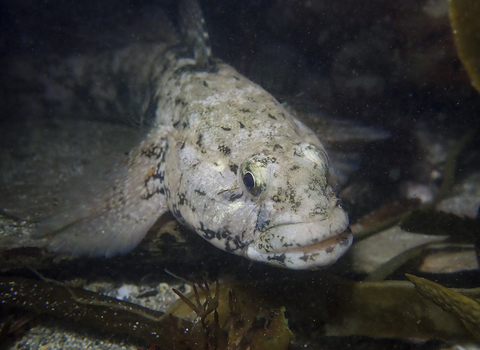
Giant goby by Paul Naylor
Giant goby
Scientific name
Gobius cobitisWhen to see
April to OctoberSpecies information
About
Britain’s largest goby, this giant of the rocky shore spends most of its time hiding in crevices and very little is known about their behaviour. It is thought that females can lay up to 12,000 eggs in small crevice ‘nests’, which males will then guard attentively. Giant gobies can change colour depending on mood and surroundings.How to identify
Giant gobies are very large fish to find on the shore and have a large head and chunky body. Characteristically they are salt and pepper speckled colouration with small and well spaced eyes. Dark blotches appear along the mid-line of the body.Distribution
South West England only, from Wembury in Devon to the Isles of Scilly. Also found in the Eastern Atlantic, Mediterranean and Black Sea.In our area
Imagine lifting a rock on the sandy shallows of Porth Hellick, expecting to find a crab or an anemone, but instead a shadow the size of your forearm darts through the water at the speed of light. At first the giant size of the goby is a shock—there are few rockpool creatures that grow that large—but once it settles, it becomes possible to admire the goby’s unusual salt and pepper scales and slightly confused expression, its small eyes unnervingly rotating in every direction. Porth Hellick on St Mary's and Covean on St Agnes are good places to look, but be careful not to touch. Giant gobies are protected and disturbing them is illegal under the Wildlife and Countryside Act (1981).
Scilly's rockpools are home to some fascinating wildlife. Find out more about some of the amazing species you might spot. Remember to follow the Seashore Code if rockpooling around the Isles of Scilly and elsewhere.
Did you know?
The giant goby is protected under the Wildlife & Countryside Act 1981, making it a criminal offence to disturb individuals or damage their rockpool homes!Imagine lifting a rock on the sandy shallows of Porth Hellick, expecting to find a crab or an anemone, but instead a shadow the size of your forearm darts through the water at the speed of light. At first the giant size of the goby is a shock—there are few rockpool creatures that grow that large—but once it settles, it becomes possible to admire the goby’s unusual salt and pepper scales and slightly confused expression, its small eyes unnervingly rotating in every direction. Porth Hellick on St Mary's and Covean on St Agnes are good places to look, but be careful not to touch. Giant gobies are protected and disturbing them is illegal under the Wildlife and Countryside Act (1981).
Scilly's rockpools are home to some fascinating wildlife. Find out more about some of the amazing species you might spot. Remember to follow the Seashore Code if rockpooling around the Isles of Scilly and elsewhere.
